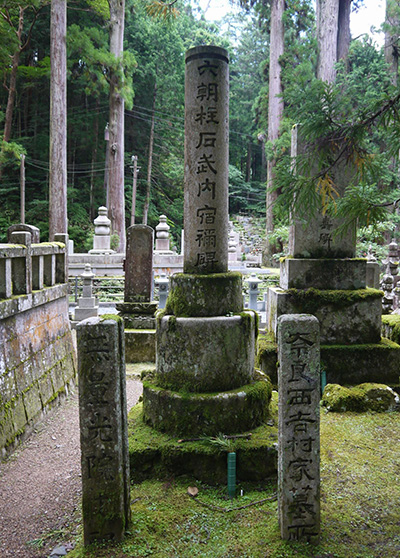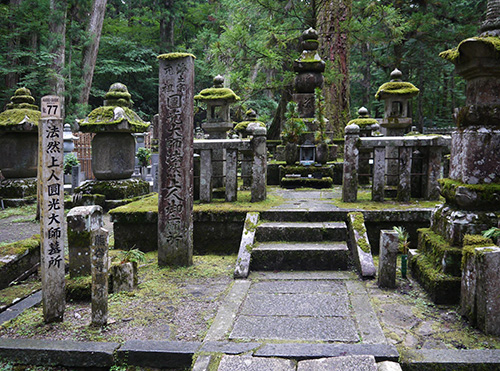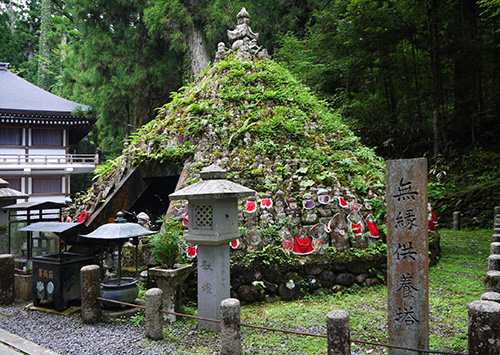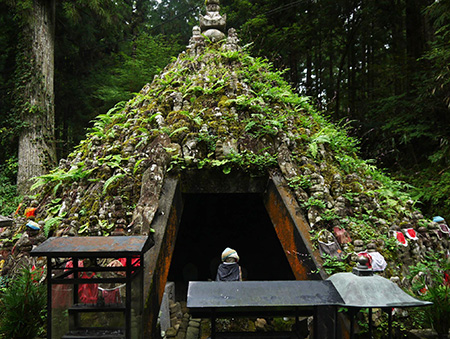


835年に空海が死去してたぶん幾ばくかの経緯があって、
空海はまだ信仰の道を生き続けているという神話がうまれ、
入定し鎮座している奥の院周辺が「もっとも涅槃に近い」場所と認識され
多くの衆生が死後の安寧利益を求めて蝟集してきた。
その総数20万基にもなるという墓標・墓域群。
現代の我々は寺の「墓地」に葬られることが自然と思っているけれど
そういう死の様式化は少なくとも仏教伝来以前には習慣はなかったはず。
また、仏教導入初期は鎮護国家思想と連動する国家意志の色合いが強く
墓をそこに建立するという習慣はなかったと言われる。
やがて寺という現世での結界、浄土に近づきうると思える場所に
最後の人間の「不動産」願望として墓地を求める意識が芽生えたのだろう。
そういう日本人の仏教との精神関係史として考えれば
この高野山奥の院墓標群は象徴的なものかも知れない。
寺と墓地という関係性の初源の姿であるようにも感じる。
いろいろ思わぬ人物の痕跡も見出されて興味深い。
戦国期以降の武将たちの墓地は多いのだけれど、
なかにはそれより遙か以前の人物も散見される。
上の2番目の墓地は「六朝の柱石」というキャッチフレーズで
記紀に名の残る忠臣、武内宿禰の名前まで発見できる。
六朝というのは天皇6代にわたって勤仕したという意味で、
まともに計算したら常識をはるかに超える年齢まで活躍した人物。
そうかと思えば「法然上人」という仏教の一宗派の創業者の墓域もある。
現代では常識化している宗派のセクト争いのようなものは
ここではまったく止揚されてしまっている。
仏教徒として法然さんはなんのこだわりもなく空海さんに仕えているとみえる。
はるかな弥勒菩薩の救世思想という仏教教義の原点に忠実だとも思える。


そういう墓標群の中でもこちらのカタチは特異。
無縁仏のための集合墓のようなのですが、
仏教伝来以前の社会で基本であった竪穴住居、
そして霊廟施設として日本古来の古墳をも想起させてくれる。
仏教伝来、寺院の建設ラッシュが統一国家形成期に一気に訪れ、
一方では古墳は急速にフェイドアウトしていく。
しかし古層の日本人意識としてこういった「鎮魂の形態」があるのだと思う。
無縁墓として竪穴の入口も開放されていて清々しい。
入口の架構は鉄さびも見られるので鉄骨で造作されているようにも見える。
近現代になって集合墓の需要が生まれてきたものかもしれません。
高齢化社会が進行・深化してきている日本社会。
こういう「死後の不動産」というものの選択肢の多様化も身近なものになるか。
先人たちのこういう「選択」に思いが去来します。
English version⬇
[200,000 Japanese “Okunoin Tomb Mark” Group Koyasan Expedition-14]
There was probably some history of Kukai’s death in 835,
The myth that Kukai is still alive on the path of faith was born,
The area around Okunoin, which has been settled and enshrined, is recognized as the “closest to Nirvana” place.
Many sentient beings have gathered for profit.
A group of grave markers and grave areas with a total of 200,000 units.
Today we naturally think that we are buried in the “graveyard” of the temple.
Such stylization of death must not have been a custom, at least before the introduction of Buddhism.
Also, in the early days of the introduction of Buddhism, there was a strong national will that was linked to the national idea of protection.
There was no custom to build a tomb there.
Eventually, a temple, a barrier in this world, where you can approach the Pure Land
The consciousness of seeking a graveyard may have sprung up as the last human desire.
If you think of it as a history of spiritual relations with Japanese Buddhism
This group of grave markers at the back of Mt. Koya may be symbolic.
I also feel that it is the first source of the relationship between a temple and a graveyard.
It is interesting to find traces of various unexpected people.
There are many graveyards for military commanders since the Warring States period,
Some people are far earlier than that.
The second graveyard above is with the catchphrase “Scapolite of the Sixth Generation”
You can even discover the name of Takenouchi no Sukune, a loyal retainer of the Kiki era.
The sixth generation means that he served for the sixth generation of the emperor.
A person who was active until an age far beyond common sense when calculated properly.
If you think so, there is also a grave area of the founder of a Buddhist sect called “Honen Shonin.”
Something like the sect struggle of denominations that has become common sense in modern times
It has been completely suspended here.
As a Buddhist, Honen seems to serve Kukai without any particular commitment.
It seems to be faithful to the origin of the Buddhist doctrine of the distant Maitreya Bodhisattva’s thought of salvation.
This shape is peculiar among such grave markers.
It’s like a collective tomb for an unrelated Buddha,
A pit-house as a residence, which was basic in society before the introduction of Buddhism
It also reminds us of an ancient burial mound as a mausoleum facility.
Buddhism was introduced, and the rush to build temples came during the period of unified nation formation.
On the other hand, the tumulus fades out rapidly.
I think that there is such a “form of requiescats” as the Japanese consciousness of the old age.
The entrance to the pit is open as an unrelated tomb, and it is refreshing.
The frame at the entrance also looks like it is made of steel because iron rust can be seen.
Or it may be that the demand for collective tombs was born in modern times.
Japanese society where the aging society is progressing and deepening.
Will the idea of ”real estate after death” gradually become familiar?
My thoughts come to this kind of “choice” of our predecessors.
Posted on 11月 11th, 2021 by 三木 奎吾
Filed under: 住宅マーケティング, 日本社会・文化研究







コメントを投稿
「※誹謗中傷や、悪意のある書き込み、営利目的などのコメントを防ぐために、投稿された全てのコメントは一時的に保留されますのでご了承ください。」
You must be logged in to post a comment.